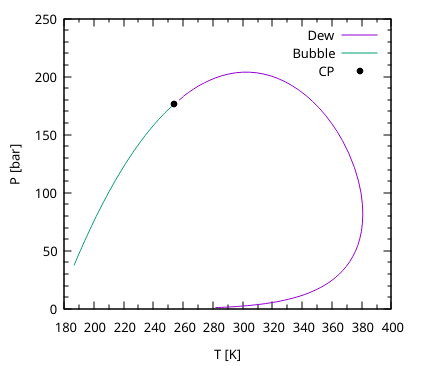Phase Equilibrium
Phase Equilibria calculations are fundamental for the majority of EoS based modelling either for processes or when studying phase-behaviour.
In yaeos most of phase-equilibria procedures return the EquilibriumState
type EquilibriumState, which holds all the relevant information of an
equilibria point.
The implemented methods, and their usage are:
Flash calculations
Flash calcuations are one of the most used phase-equilibria calculations during modelling of processes.
In yaeos it is possible to make Flash calculations either specifying:
type(EquilibriaState) :: result
! zPT flash
result = flash(model, z, p_spec=P, T=T)
! zVT flash
result = flash(model, z, v_spec=P, T=T)
! It is possible to provide initialization compositions in terms of the
! K-factors. Where k0=y/x
result = flash(model, z, v_spec=P, T=T, k0=k0)
It is also possible to make flash calculations with models. In that
case, it is important to ignore the v_spec and p_spec arguments, and provide
an initial guess for -values. A good way of estimating initial
values is by using the mintpd subroutine. For example:
integer, parameter :: nc = 3
type(UNIFAC) :: model
type(Groups) :: molecules(nc)
real(pr) :: n(nc), w(nc), T
type(EquilibriumState) :: fr
real(pr) :: mintpd
integer :: i
! Define the groups of the three molecules
molecules(1)%groups_ids = [1, 42]
molecules(1)%number_of_groups = [1, 1]
molecules(2)%groups_ids = [1, 2]
molecules(2)%number_of_groups = [2, 4]
molecules(3)%groups_ids = [16]
molecules(3)%number_of_groups = [1]
! Temperature
T = 250
! Moles
n = [0.2, 0.7, 0.1]
! setup UNIFAC model
model = setup_unifac(molecules)
! Find the composition that provides the mininum tpd
call min_tpd(model, n, P=1._pr, T=T, mintpd=mintpd, w=w)
! Calculate the phase-split flash
fr = flash(model, n, T, k0=w/n, iters=i)
Saturation points
Single saturation point calculations are included with the procedures saturation_pressure and saturation_temperature. Both procedures solve the equation
With a newton procedure with respect to the desired variable (either or , and updating the values of at each point with
type(EquilibriaState) :: sat_point
sat = saturation_pressure(model, z, T=T, kind="bubble")
sat = saturation_pressure(model, z, T=T, kind="dew")
sat = saturation_temperature(model, z, P=P, kind="bubble")
sat = saturation_temperature(model, z, P=P, kind="dew")
Phase envelopes
Phase envelopes are the conection of all the saturation points of a system. When the interest is in calculating a whole phase diagram instead of a single point, or the point is hard to converge. It is better to use a robust mathematical algorithm that eases the calcuation providing an easy-to-converge point and using its information to initialize a next one and continue along the whole phase-boundary.
In yaeos all kind of phase envelopes are calculated using the numerical
continuation method. This method is extremely useful to calculate lines that
can be defined as a undertemined system , which has one degree
of freedom left. This degree of freedom can be used to define an extra equation
Where ns is the index of some specified variable from , and
is some specified value. Now the system has no degree
of freedom left and can be solved by traditional methods like Newton-Raphson.
When one point is solved, it is possible to determine how the vector of variables change with respect to the specified variable by solving the following system of equations:
Knowing the sensitivities vector, we can select the next variable to specify by selecting the one that has the highest absolute value of . And a good extrapolation to calculate the next point can be obtained with
Isopleths
type(PTEnvel2) :: env
sat = saturation_pressure(model, z, T=150._pr, kind="bubble")
env = pt_envelope_2ph(model, z, sat)
